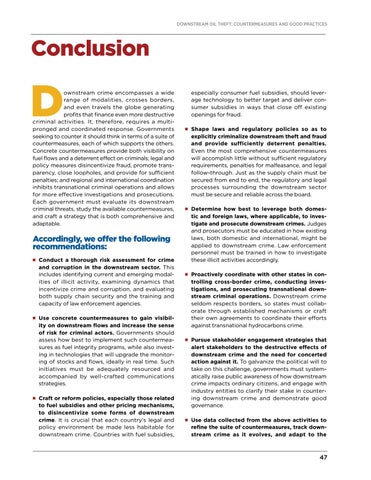DOWNSTREAM OIL THEFT: COUNTERMEASURES AND GOOD PRACTICES
Conclusion
D
ownstream crime encompasses a wide range of modalities, crosses borders, and even travels the globe generating profits that finance even more destructive criminal activities. It, therefore, requires a multipronged and coordinated response. Governments seeking to counter it should think in terms of a suite of countermeasures, each of which supports the others. Concrete countermeasures provide both visibility on fuel flows and a deterrent effect on criminals; legal and policy measures disincentivize fraud, promote transparency, close loopholes, and provide for sufficient penalties; and regional and international coordination inhibits transnational criminal operations and allows for more effective investigations and prosecutions. Each government must evaluate its downstream criminal threats, study the available countermeasures, and craft a strategy that is both comprehensive and adaptable.
especially consumer fuel subsidies, should leverage technology to better target and deliver consumer subsidies in ways that close off existing openings for fraud. ■
Shape laws and regulatory policies so as to explicitly criminalize downstream theft and fraud and provide sufficiently deterrent penalties. Even the most comprehensive countermeasures will accomplish little without sufficient regulatory requirements, penalties for malfeasance, and legal follow-through. Just as the supply chain must be secured from end to end, the regulatory and legal processes surrounding the downstream sector must be secure and reliable across the board.
■
Determine how best to leverage both domestic and foreign laws, where applicable, to investigate and prosecute downstream crimes. Judges and prosecutors must be educated in how existing laws, both domestic and international, might be applied to downstream crime. Law enforcement personnel must be trained in how to investigate these illicit activities accordingly.
■
Proactively coordinate with other states in controlling cross-border crime, conducting investigations, and prosecuting transnational downstream criminal operations. Downstream crime seldom respects borders, so states must collaborate through established mechanisms or craft their own agreements to coordinate their efforts against transnational hydrocarbons crime.
■
Pursue stakeholder engagement strategies that alert stakeholders to the destructive effects of downstream crime and the need for concerted action against it. To galvanize the political will to take on this challenge, governments must systematically raise public awareness of how downstream crime impacts ordinary citizens, and engage with industry entities to clarify their stake in countering downstream crime and demonstrate good governance.
■
Use data collected from the above activities to refine the suite of countermeasures, track downstream crime as it evolves, and adapt to the
Accordingly, we offer the following recommendations: ■
■
■
Conduct a thorough risk assessment for crime and corruption in the downstream sector. This includes identifying current and emerging modalities of illicit activity, examining dynamics that incentivize crime and corruption, and evaluating both supply chain security and the training and capacity of law enforcement agencies. Use concrete countermeasures to gain visibility on downstream flows and increase the sense of risk for criminal actors. Governments should assess how best to implement such countermeasures as fuel integrity programs, while also investing in technologies that will upgrade the monitoring of stocks and flows, ideally in real time. Such initiatives must be adequately resourced and accompanied by well-crafted communications strategies. Craft or reform policies, especially those related to fuel subsidies and other pricing mechanisms, to disincentivize some forms of downstream crime. It is crucial that each country’s legal and policy environment be made less habitable for downstream crime. Countries with fuel subsidies,
47





